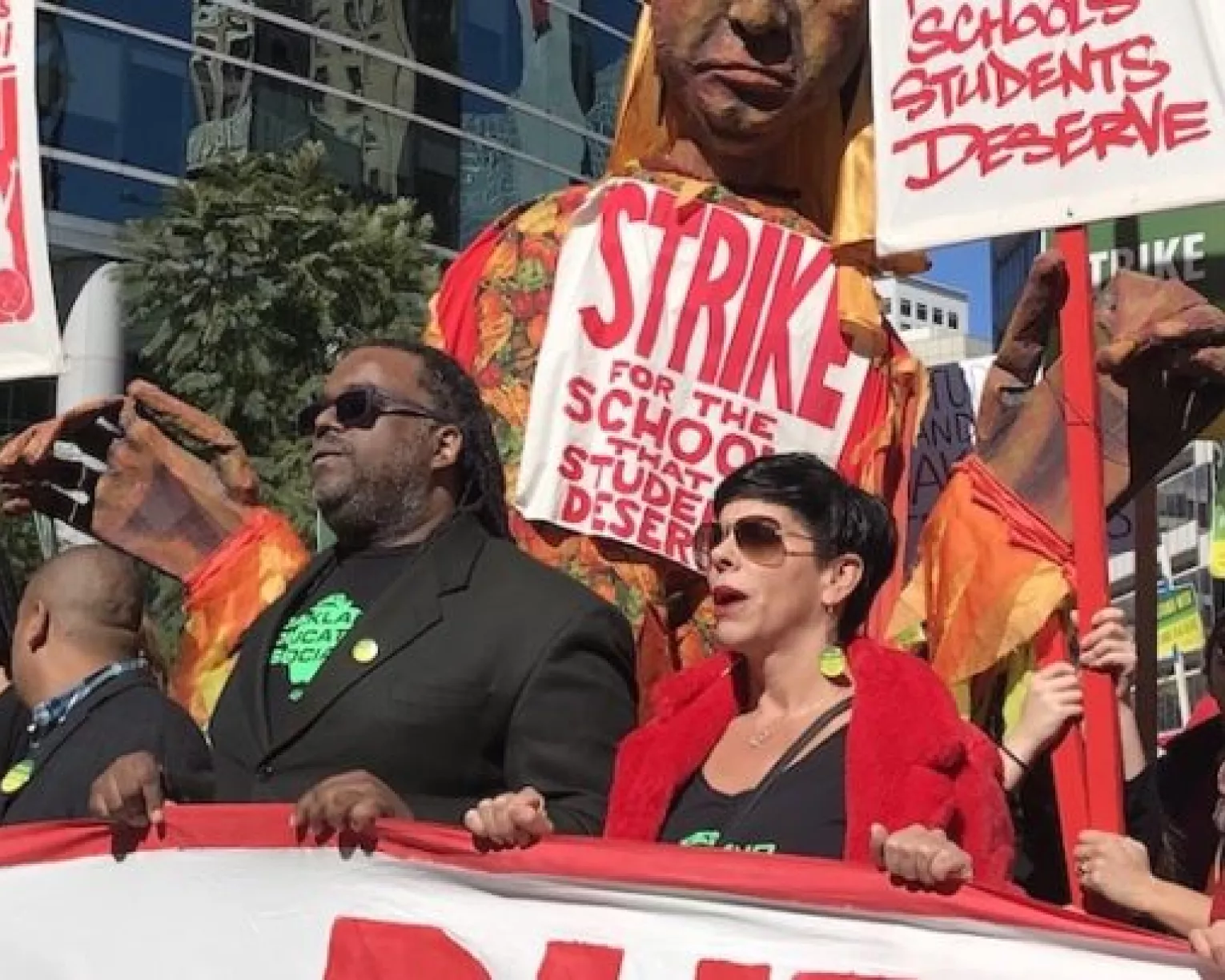In the fast-paced, worldwide, competitive workplace we now live in, our traditional school models are not capable of meeting the needs of the 21st century student. All students—preK through graduate students—need to develop advanced critical thinking and information literacy skills and master new digital tools. At the same time, they need to develop the initiative to become self-directed learners while adapting to the ever-changing digital information landscape.
This shifting landscape creates new opportunities for NEA, our affiliates, our members, and our profession in preschools, public elementary and secondary schools, and postsecondary institutions. The appropriate use of technology in education—as defined by educators rather than entities driven by for-profit motives—will improve student learning, quality of instruction, and education employee effectiveness, and will provide opportunities to eradicate educational inequities.
Digital technologies create new opportunities for accelerating, expanding, and individualizing learning. Our members and students are already actively engaged in building the schools and campuses of the future—including quality online communities. Increasingly, educators (including teachers, librarians/media specialists, faculty, and ESP staff) are becoming curriculum designers who orchestrate the delivery of content using multiple instructional methods and technologies both within and beyond the traditional instructional day. Teaching and learning can now occur beyond the limitations of time and space.
NEA embraces this new environment and these new technologies to better prepare our students for college and for 21st century careers.
Ensure Equity to Meet the Needs of Every Student
NEA believes that educational programs and strategies designed to close the achievement and digital gaps must address equity issues related to broadband Internet access, software and technical support, and hardware maintenance. Also, technical support must be adequate to ensure that digital classrooms function properly and reliably for both educators and students. Under our current inequitable system of funding, simply moving to a large scale use of technology in preK–12 and postsecondary education will more likely widen achievement gaps among students than close them. For example, school districts with lower income populations simply will not be able to provide or maintain appropriate and relevant digital tools and resources for their students. We as a nation must address the issues of equity and access in a comprehensive manner in order to see the promise and realize the opportunities that digital learning can provide.
To that end, NEA believes that student learning needs can best be met by public school districts and postsecondary institutions working in collaboration with educators and local associations to develop comprehensive and thorough digital learning plans that address all the elements of incorporating technology into the instructional program. These plans should be living documents, constantly reviewed and adapted as changing circumstances require, but always keeping the focus on student learning. Implementation of these plans should honor experimentation and creativity as part of the learning process for both educators and students, while always maintaining support for the professional judgment of educators. It is of critical 20 importance that the use of technology is recognized as a tool that assists and enhances the learning process, and is not the driver of the digital learning plan.
These plans also should include the provision of adaptive technologies to meet individual students’ needs, including assistive technology to support students who are English Language Learners and students with a variety of disabilities or challenges.
Support and Enhance Educator Professionalism
NEA believes that the increasing use of technology in preK to graduate level classrooms will transform the role of educators allowing the educational process to become ever more studentcentered. This latest transformation is not novel, but part of the continuing evolution of our education system. Educators, as professionals working in the best interests of their students, will continue to adjust and adapt their instructional practice and use of digital technology/tools to meet the needs and enhance the learning of their students.
All educators are essential to student learning and should have access to relevant, high-quality, interactive professional development in the integration of digital learning and the use of technology into their instruction and practice. Teachers need access to relevant training on how to use technology and incorporate its use into their instruction, ESPs need access to training on how best to support the use of technology in classrooms, and administrators need training to make informed decisions about purchasing equipment, technology use, course assignments, and personnel assignments. School districts and postsecondary institutions need to ensure that they provide interactive professional development on an ongoing basis, and to provide time for all educators to take advantage of those opportunities. The training needs to address both the basic preparation on how to make the technology work, and how to most effectively incorporate it into the educational program.
Educator candidates need problem-solving and creativity experiences and should have the opportunity to learn different strategies throughout their pre-service education and regular professional development so they are prepared for using not only the technology of today, but of tomorrow.
In these changing roles, it is important to protect the rights of educators, and to fairly evaluate the accomplishments of educational institutions as a whole. For example, the use of supplemental, remedial, or course recovery online instruction can affect the hours, wages, and working conditions of all educational employees, but can dramatically affect college and university faculty and staff. Educators and their local associations need support and assistance in vetting the quality of digital course materials and in developing or accessing trusted digital venues to share best practices and provide support.
Furthermore, education employees should own the copyright to materials that they create in the course of their employment. There should be an appropriate “teacher’s exception” to the “works made for hire” doctrine, pursuant to which works created by education employees in the course of their employment are owned by the employee. This exception should reflect the unique practices and traditions of academia.
All issues relating to copyright ownership of materials created by education employees should be resolved through collective bargaining or other process of bilateral decisionmaking between the employer and the affiliate.
The ownership rights of education employees who create copyrightable materials should not prevent education employees from making appropriate use of such materials in providing educational services to their students.
Enhance and Enrich Student Learning
Optimal learning environments should neither be totally technology free, nor should they be totally online and devoid of educator and peer interaction. The Association believes that an environment that maximizes student learning will use a “blended” and/or “hybrid” model situated somewhere along a continuum between these two extremes.
NEA believes there is no one perfect integration of technology and traditional forms of delivering education for all students. Every class will need to be differentiated, and at some level every student needs a different approach. Professional educators are in the best position and must be directly involved in determining what combination works best in particular classes and with particular students.
Students’ maturity and developmental status determines how students adapt to the use of digital technology as they continually face more challenging materials. The use of technology in the classroom will help build self-reliance and motivation in students, but it must be appropriate to their developmental and skill level, as determined by professional educators.
As different digital tools are created and used, the impact of technology on traditional socialization roles must be considered. The face-to-face relationship between student and educator is critical to increasing student learning, and students’ interactions with each other are an important part of their socialization into society.
Additionally, assessment and accountability systems need to be carefully developed to ensure academic integrity and accurately measure the impact on students. Sensible guidelines and strategies should be used to ensure students are completing their own online assignments and taking the appropriate assessments.
The Role of the Association in Promoting High Quality, Digital Learning
The development and implementation of high quality digital learning must be a top priority of NEA and its affiliates. The Representative Assembly, therefore, directs that NEA demonstrate its support of digital learning by providing leadership and sharing learning opportunities to develop and implement high quality digital learning that enhances instruction and improves student learning. The Representative Assembly strongly encourages NEA to do this work in the field of digital learning in partnership with trusted organizations and experts who can work at the national, state, and local levels to assist states, school districts, colleges and universities, and local associations in developing their capacity for high quality digital learning.
The Representative Assembly also directs NEA to encourage its members and utilize their expertise to engage in professional learning that enhances their understanding of how to creatively and appropriately integrate digital tools and high quality digital learning into their instruction. Such professional learning should include sharing of expertise by members who can serve as valuable mentors and professional partners for other members who are new to digital instruction.
The Representative Assembly further directs that NEA work with stakeholders, including parents, students, and policy makers, to seize the opportunities that digital technologies provide. Some educators now have access to the technological tools to further professionalize teaching, vastly enhance and enrich student learning, and meet the individual needs of every student. It is time to ensure that ALL educators have access and are prepared to use these digital tools.
Addendum
Blended and/or Hybrid Learning
Blended and/or hybrid learning is an integrated instructional approach in which a student learns, at least in part, at a supervised physical location away from home and through online delivery where the student has control over at least some aspects of the time and place of accessing the curriculum. The Policy Statement supports maximizing student learning by using both technology and real life educators in the process. It rejects the idea that effective learning can take place completely online and without interaction with certified teachers and fully qualified faculty.
The Definition of Fully Qualified Educators
The term “educator” includes teachers, librarians/media specialists, and education support professionals in preK–12 public schools, and faculty and staff of higher education institutions. Educators should be fully qualified, certified, and/or licensed to teach the subjects they are teaching, including in online instructional settings.
Technology as a Tool
Technology is a tool to enhance and enrich instruction for students, and should not be used to replace educational employees who work with students or limit their employment.
Special Education Services
Use of virtual learning to provide instruction to students receiving special education services for behavioral/self-regulation needs will be determined by the IEP Team. The enrollment in a virtual school will not be used as a behavior consequence.
Data Privacy
Safeguarding personal data must also be a top priority of NEA and its affiliates. NEA needs to demonstrate its commitment to protecting data privacy. Educators need to be informed about FERPA and state data privacy laws, regulations, and policies. NEA believes that professional development needs to include instruction about data privacy, including responsibilities and the rights of whistleblowers in the event of reporting a violation.
Learn More
Are you an affiliate?





